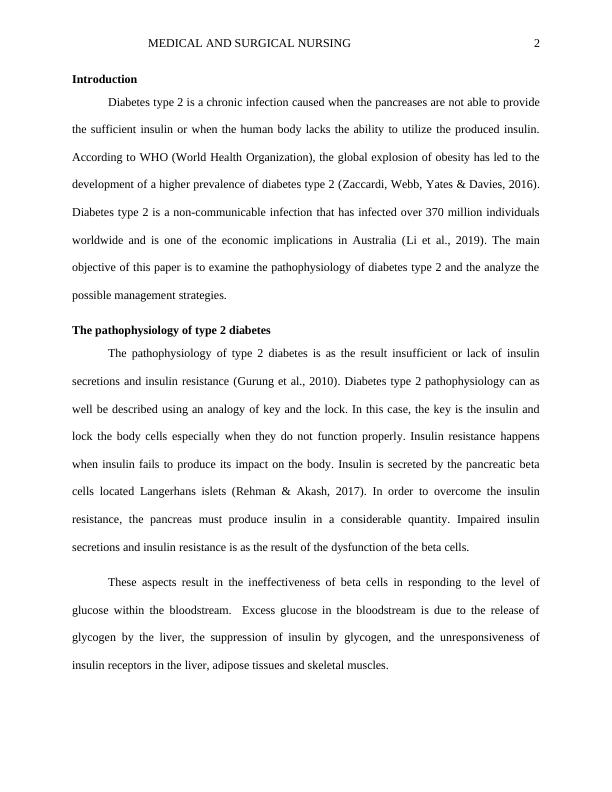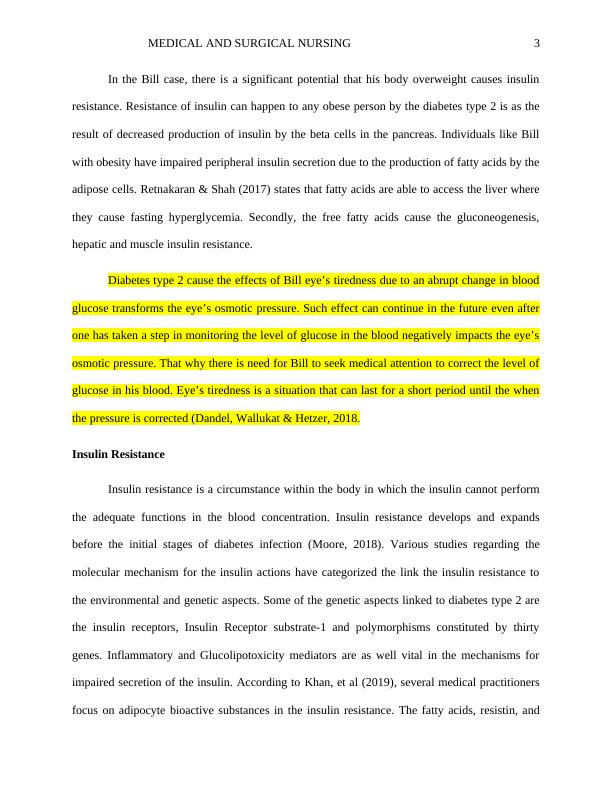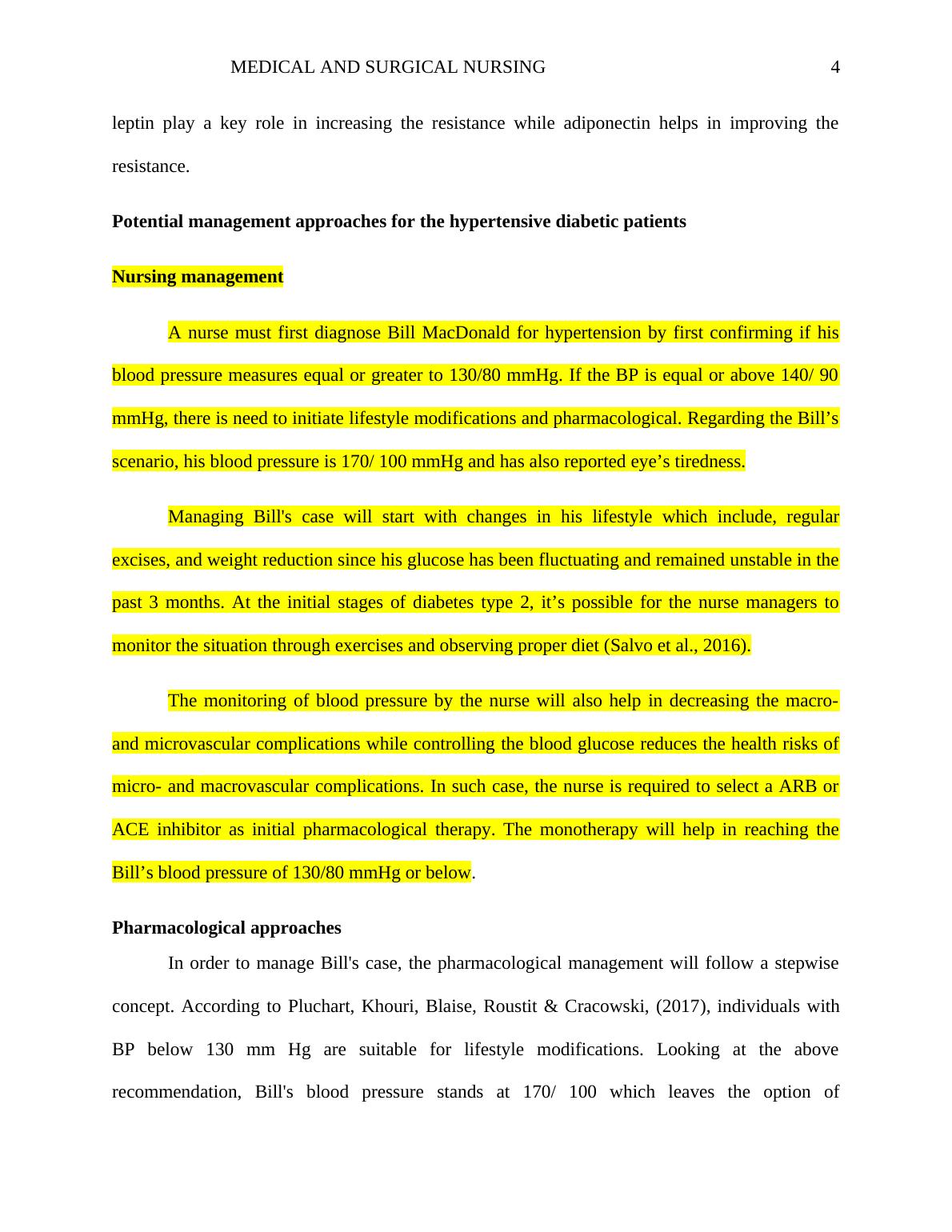Medical And Surgical Nursing Assignment 2022
Added on 2022-09-18
11 Pages2796 Words31 Views
Running head: MEDICAL AND SURGICAL NURSING 1
Medical and Surgical Nursing
Student’s name
Professor
Institutional Affiliation
Date
Medical and Surgical Nursing
Student’s name
Professor
Institutional Affiliation
Date

MEDICAL AND SURGICAL NURSING 2
Introduction
Diabetes type 2 is a chronic infection caused when the pancreases are not able to provide
the sufficient insulin or when the human body lacks the ability to utilize the produced insulin.
According to WHO (World Health Organization), the global explosion of obesity has led to the
development of a higher prevalence of diabetes type 2 (Zaccardi, Webb, Yates & Davies, 2016).
Diabetes type 2 is a non-communicable infection that has infected over 370 million individuals
worldwide and is one of the economic implications in Australia (Li et al., 2019). The main
objective of this paper is to examine the pathophysiology of diabetes type 2 and the analyze the
possible management strategies.
The pathophysiology of type 2 diabetes
The pathophysiology of type 2 diabetes is as the result insufficient or lack of insulin
secretions and insulin resistance (Gurung et al., 2010). Diabetes type 2 pathophysiology can as
well be described using an analogy of key and the lock. In this case, the key is the insulin and
lock the body cells especially when they do not function properly. Insulin resistance happens
when insulin fails to produce its impact on the body. Insulin is secreted by the pancreatic beta
cells located Langerhans islets (Rehman & Akash, 2017). In order to overcome the insulin
resistance, the pancreas must produce insulin in a considerable quantity. Impaired insulin
secretions and insulin resistance is as the result of the dysfunction of the beta cells.
These aspects result in the ineffectiveness of beta cells in responding to the level of
glucose within the bloodstream. Excess glucose in the bloodstream is due to the release of
glycogen by the liver, the suppression of insulin by glycogen, and the unresponsiveness of
insulin receptors in the liver, adipose tissues and skeletal muscles.
Introduction
Diabetes type 2 is a chronic infection caused when the pancreases are not able to provide
the sufficient insulin or when the human body lacks the ability to utilize the produced insulin.
According to WHO (World Health Organization), the global explosion of obesity has led to the
development of a higher prevalence of diabetes type 2 (Zaccardi, Webb, Yates & Davies, 2016).
Diabetes type 2 is a non-communicable infection that has infected over 370 million individuals
worldwide and is one of the economic implications in Australia (Li et al., 2019). The main
objective of this paper is to examine the pathophysiology of diabetes type 2 and the analyze the
possible management strategies.
The pathophysiology of type 2 diabetes
The pathophysiology of type 2 diabetes is as the result insufficient or lack of insulin
secretions and insulin resistance (Gurung et al., 2010). Diabetes type 2 pathophysiology can as
well be described using an analogy of key and the lock. In this case, the key is the insulin and
lock the body cells especially when they do not function properly. Insulin resistance happens
when insulin fails to produce its impact on the body. Insulin is secreted by the pancreatic beta
cells located Langerhans islets (Rehman & Akash, 2017). In order to overcome the insulin
resistance, the pancreas must produce insulin in a considerable quantity. Impaired insulin
secretions and insulin resistance is as the result of the dysfunction of the beta cells.
These aspects result in the ineffectiveness of beta cells in responding to the level of
glucose within the bloodstream. Excess glucose in the bloodstream is due to the release of
glycogen by the liver, the suppression of insulin by glycogen, and the unresponsiveness of
insulin receptors in the liver, adipose tissues and skeletal muscles.

MEDICAL AND SURGICAL NURSING 3
In the Bill case, there is a significant potential that his body overweight causes insulin
resistance. Resistance of insulin can happen to any obese person by the diabetes type 2 is as the
result of decreased production of insulin by the beta cells in the pancreas. Individuals like Bill
with obesity have impaired peripheral insulin secretion due to the production of fatty acids by the
adipose cells. Retnakaran & Shah (2017) states that fatty acids are able to access the liver where
they cause fasting hyperglycemia. Secondly, the free fatty acids cause the gluconeogenesis,
hepatic and muscle insulin resistance.
Diabetes type 2 cause the effects of Bill eye’s tiredness due to an abrupt change in blood
glucose transforms the eye’s osmotic pressure. Such effect can continue in the future even after
one has taken a step in monitoring the level of glucose in the blood negatively impacts the eye’s
osmotic pressure. That why there is need for Bill to seek medical attention to correct the level of
glucose in his blood. Eye’s tiredness is a situation that can last for a short period until the when
the pressure is corrected (Dandel, Wallukat & Hetzer, 2018.
Insulin Resistance
Insulin resistance is a circumstance within the body in which the insulin cannot perform
the adequate functions in the blood concentration. Insulin resistance develops and expands
before the initial stages of diabetes infection (Moore, 2018). Various studies regarding the
molecular mechanism for the insulin actions have categorized the link the insulin resistance to
the environmental and genetic aspects. Some of the genetic aspects linked to diabetes type 2 are
the insulin receptors, Insulin Receptor substrate-1 and polymorphisms constituted by thirty
genes. Inflammatory and Glucolipotoxicity mediators are as well vital in the mechanisms for
impaired secretion of the insulin. According to Khan, et al (2019), several medical practitioners
focus on adipocyte bioactive substances in the insulin resistance. The fatty acids, resistin, and
In the Bill case, there is a significant potential that his body overweight causes insulin
resistance. Resistance of insulin can happen to any obese person by the diabetes type 2 is as the
result of decreased production of insulin by the beta cells in the pancreas. Individuals like Bill
with obesity have impaired peripheral insulin secretion due to the production of fatty acids by the
adipose cells. Retnakaran & Shah (2017) states that fatty acids are able to access the liver where
they cause fasting hyperglycemia. Secondly, the free fatty acids cause the gluconeogenesis,
hepatic and muscle insulin resistance.
Diabetes type 2 cause the effects of Bill eye’s tiredness due to an abrupt change in blood
glucose transforms the eye’s osmotic pressure. Such effect can continue in the future even after
one has taken a step in monitoring the level of glucose in the blood negatively impacts the eye’s
osmotic pressure. That why there is need for Bill to seek medical attention to correct the level of
glucose in his blood. Eye’s tiredness is a situation that can last for a short period until the when
the pressure is corrected (Dandel, Wallukat & Hetzer, 2018.
Insulin Resistance
Insulin resistance is a circumstance within the body in which the insulin cannot perform
the adequate functions in the blood concentration. Insulin resistance develops and expands
before the initial stages of diabetes infection (Moore, 2018). Various studies regarding the
molecular mechanism for the insulin actions have categorized the link the insulin resistance to
the environmental and genetic aspects. Some of the genetic aspects linked to diabetes type 2 are
the insulin receptors, Insulin Receptor substrate-1 and polymorphisms constituted by thirty
genes. Inflammatory and Glucolipotoxicity mediators are as well vital in the mechanisms for
impaired secretion of the insulin. According to Khan, et al (2019), several medical practitioners
focus on adipocyte bioactive substances in the insulin resistance. The fatty acids, resistin, and

MEDICAL AND SURGICAL NURSING 4
leptin play a key role in increasing the resistance while adiponectin helps in improving the
resistance.
Potential management approaches for the hypertensive diabetic patients
Nursing management
A nurse must first diagnose Bill MacDonald for hypertension by first confirming if his
blood pressure measures equal or greater to 130/80 mmHg. If the BP is equal or above 140/ 90
mmHg, there is need to initiate lifestyle modifications and pharmacological. Regarding the Bill’s
scenario, his blood pressure is 170/ 100 mmHg and has also reported eye’s tiredness.
Managing Bill's case will start with changes in his lifestyle which include, regular
excises, and weight reduction since his glucose has been fluctuating and remained unstable in the
past 3 months. At the initial stages of diabetes type 2, it’s possible for the nurse managers to
monitor the situation through exercises and observing proper diet (Salvo et al., 2016).
The monitoring of blood pressure by the nurse will also help in decreasing the macro-
and microvascular complications while controlling the blood glucose reduces the health risks of
micro- and macrovascular complications. In such case, the nurse is required to select a ARB or
ACE inhibitor as initial pharmacological therapy. The monotherapy will help in reaching the
Bill’s blood pressure of 130/80 mmHg or below.
Pharmacological approaches
In order to manage Bill's case, the pharmacological management will follow a stepwise
concept. According to Pluchart, Khouri, Blaise, Roustit & Cracowski, (2017), individuals with
BP below 130 mm Hg are suitable for lifestyle modifications. Looking at the above
recommendation, Bill's blood pressure stands at 170/ 100 which leaves the option of
leptin play a key role in increasing the resistance while adiponectin helps in improving the
resistance.
Potential management approaches for the hypertensive diabetic patients
Nursing management
A nurse must first diagnose Bill MacDonald for hypertension by first confirming if his
blood pressure measures equal or greater to 130/80 mmHg. If the BP is equal or above 140/ 90
mmHg, there is need to initiate lifestyle modifications and pharmacological. Regarding the Bill’s
scenario, his blood pressure is 170/ 100 mmHg and has also reported eye’s tiredness.
Managing Bill's case will start with changes in his lifestyle which include, regular
excises, and weight reduction since his glucose has been fluctuating and remained unstable in the
past 3 months. At the initial stages of diabetes type 2, it’s possible for the nurse managers to
monitor the situation through exercises and observing proper diet (Salvo et al., 2016).
The monitoring of blood pressure by the nurse will also help in decreasing the macro-
and microvascular complications while controlling the blood glucose reduces the health risks of
micro- and macrovascular complications. In such case, the nurse is required to select a ARB or
ACE inhibitor as initial pharmacological therapy. The monotherapy will help in reaching the
Bill’s blood pressure of 130/80 mmHg or below.
Pharmacological approaches
In order to manage Bill's case, the pharmacological management will follow a stepwise
concept. According to Pluchart, Khouri, Blaise, Roustit & Cracowski, (2017), individuals with
BP below 130 mm Hg are suitable for lifestyle modifications. Looking at the above
recommendation, Bill's blood pressure stands at 170/ 100 which leaves the option of

End of preview
Want to access all the pages? Upload your documents or become a member.
Related Documents
Nursing Assignment: Diabetes Mellitus Case Studylg...
|9
|1531
|49
The American Journal of Medicineslg...
|11
|2436
|24
Biochemistry Assignment (Doc)lg...
|5
|921
|119
Nursing Patient Care Plan Essaylg...
|12
|4258
|51
Essay about the Nursing 2022lg...
|10
|2785
|26
Diabetes Mellitus - Type 2lg...
|6
|1322
|217
